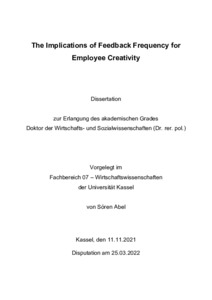| dcterms.abstract | Managers are still floundering when they have to decide on the optimal level of feedback frequency; either when they consider themselves as a source of feedback, but also when they shape the feedback environment of their employees, e.g., by allowing more (or less) frequent customer feedback. Furthermore, given that feedback is a time-consuming task, managers might be reluctant to provide feedback frequently, foregoing a potentially powerful lever for increasing employee creativity. Ultimately, clarifying the ambiguities about the implications of feedback frequency on employee creativity is essential since feedback frequency is an inevitable managerial decision – even no feedback has a frequency. Consequently, a major goal of this dissertation is to fill this research gap and examine the effects of feedback frequency on employee creativity. In doing so, I make important contributions to various streams of literature, such as management control system research, the feedback literature, service research, and gender research. As an empirical basis, three distinct studies are conducted, two surveys (n = 385; n = 400) and one field experiment (n = 105), and the data is analyzed with state-of-the-art procedures, e.g., PLS-POS, FIMIX-PLS, or high-creativity idea identification (cf. Hair et al. 2016; Kachelmeier, Wang, and Williamson 2019; Matthews et al. 2016). Indeed, my results reveal that the frequency of feedback is a powerful lever for managers to enhance employee creativity. However, the findings underline the imperative of a thoughtful decision about the frequency of the provided feedback. Furthermore, I discuss how these insights can be exploited by managers to design superior feedback strategies. | eng |

